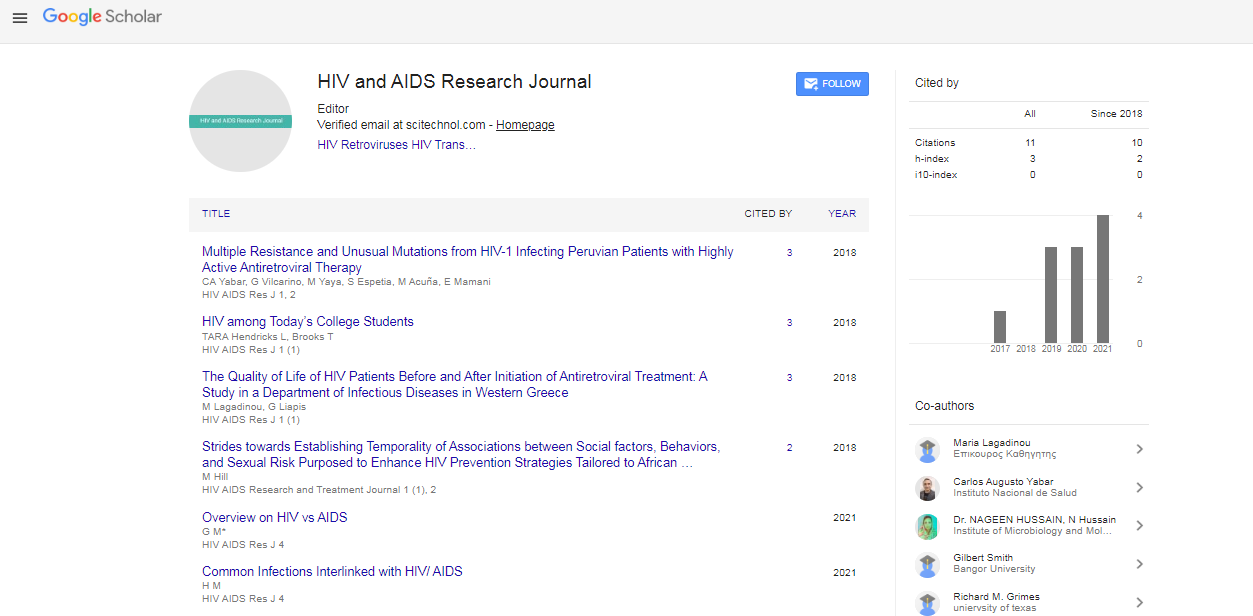Commentary, Hiv Aids Res J Vol: 6 Issue: 4
Unveiling the Dynamics of HIV Retroviruses: Impact, Insights and Advances
Robert Lawson*
1Department of Medicine, University of Verona, Verona, Italy
*Corresponding Author: Robert Lawson,
Department of Medicine, University of
Verona, Verona, Italy
E-mail: laswsonroberts@gmail.com
Received date: 04 December, 2023, Manuscript No. HARJ-24-124114;
Editor assigned date: 06 December, 2023, PreQC No. HARJ-24-124114 (PQ);
Reviewed date: 20 December, 2023, QC No. HARJ-24-124114;
Revised date: 28 December, 2023, Manuscript No. HARJ-24-124114 (R);
Published date: 05 January, 2024 DOI: 10.4172/Harj.1000130
Citation: Lawson R (2024) Unveiling the Dynamics of HIV Retroviruses: Impact, Insights and Advances. HIV AIDS Res J 6:4.
Description
Human Immunodeficiency Virus (HIV) stands as a formidable health challenge worldwide, causing Acquired Immunodeficiency Syndrome (AIDS) and impacting millions of lives. HIV belongs to a group of viruses called retroviruses, characterized by their unique ability to convert their RNA genome into DNA, integrating it into the host cell's genetic material.
Structure of HIV retroviruses
At the core of HIV's structure lies its RNA genome encapsulated within a protein shell called the capsid. This capsid is surrounded by a lipid bilayer envelope derived from the host cell membrane. Protruding from this envelope are glycoproteins, notably gp120 and gp41, essential for viral entry into host cells by binding to CD4 receptors and co-receptors, primarily CCR5 or CXCR4, present on immune cells such as CD4+ T lymphocytes.
Replication cycle
The replication cycle of HIV is a multistep process involving entry, reverse transcription, integration, transcription, translation, assembly, and budding. The virus enters the host cell by fusing its envelope with the host cell membrane or through endocytosis. Once inside, the viral RNA is reverse transcribed into DNA by the enzyme reverse transcriptase. This viral DNA is then integrated into the host cell's genome with the help of the integrase enzyme, becoming a provirus.
The provirus can remain dormant or undergo transcription by the host cell machinery to produce new viral RNA and proteins. These components are assembled into new virions, which bud off from the host cell, often causing its death. This continuous cycle of viral replication and destruction of CD4+ T cells weakens the immune system, leading to the progression of AIDS.
Impact on the immune system
HIV primarily targets CD4+ T lymphocytes, crucial for orchestrating the immune response against infections. By infecting and destroying these cells, HIV weakens the immune system, rendering individuals susceptible to opportunistic infections and cancers. Additionally, HIV's ability to mutate rapidly contributes to the evasion of the immune system and the development of resistance to antiretroviral therapy. This immune compromise marks the onset of AIDS, characterized by opportunistic infections and cancers that thrive in immunocompromised individuals.
Advancements in treatment and prevention
Antiretroviral Therapy (ART) has revolutionized the management of HIV/AIDS by effectively suppressing viral replication, reducing viral load, and preserving immune function. Various classes of antiretroviral drugs targeting different stages of the viral replication cycle are used in combination therapy, known as Highly Active Antiretroviral Therapy (HAART).
Furthermore, preventive measures such as pre-exposure prophylaxis for high-risk populations, early diagnosis, and access to treatment have significantly reduced HIV transmission rates. Ongoing research aims to develop vaccines and novel therapeutic approaches to combat HIV infection and improve the quality of life for those affected.
Conclusion
The saga of HIV retroviruses epitomizes the complexity of viral infections and their profound impact on human health. Unraveling the intricacies of HIV's structure, replication, and pathogenesis has paved the way for remarkable strides in treatment and prevention. However, the quest for a definitive cure remains elusive, necessitating continued research, global collaboration, and enhanced accessibility to interventions. Understanding the nuances of HIV retroviruses remains paramount in the pursuit of eradicating this global health threat.
 Spanish
Spanish  Chinese
Chinese  Russian
Russian  German
German  French
French  Japanese
Japanese  Portuguese
Portuguese  Hindi
Hindi 